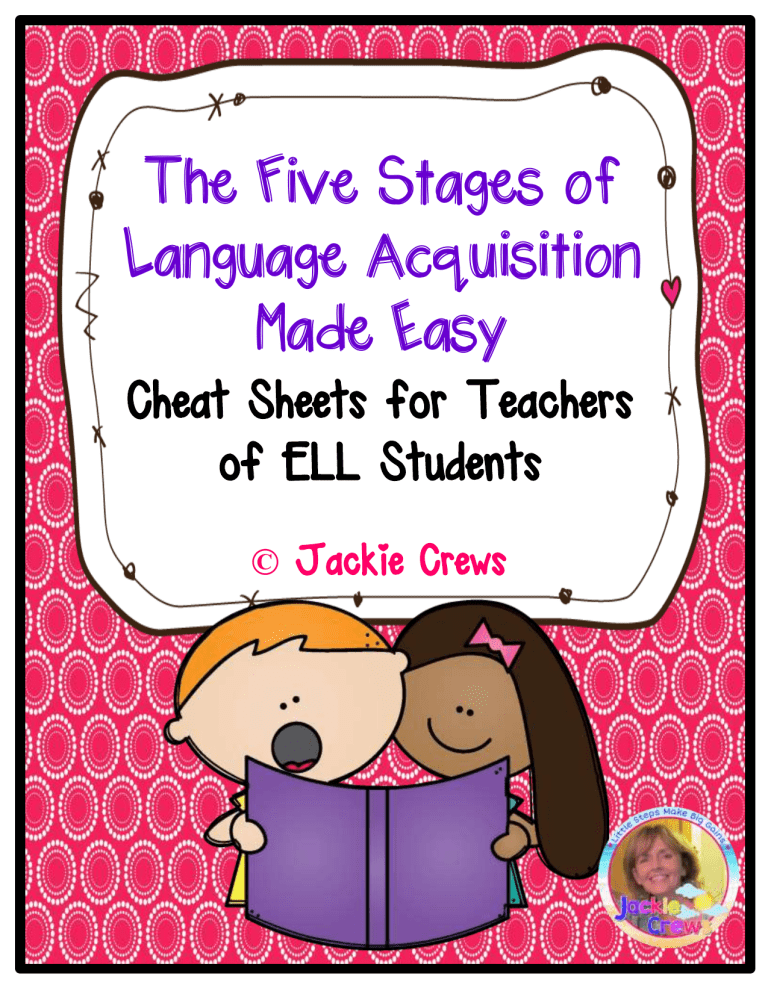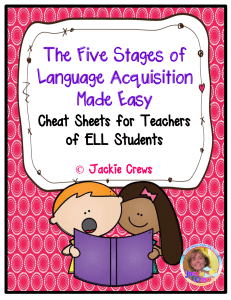
The Five Stages of Language Acquisition Made Easy Cheat Sheets for Teachers of ELL Students © Jackie Crews Special Thanks: Thank you downloading this product! I hope it will help you teach your English language learners. I hope this product is helpful and enables ESL teachers to avoid some awkward moments with those who do not understand their roles. It is my wish that classroom teachers will be more empowered by knowing the learning stages for their ELL babies. Your feedback means a lot. Please leave feedback and follow me for alerts to future products for English language learners. Followers have privileges! Sometimes I offer higher priced items half-off for the first couple days of postings. I occasionally offer follower freebies, too. https://www.teacherspayteachers.com/Store/Jackie-Crews https://www.pinterest.com/crewsliner/ https://www.facebook.com/JackieCrews.TPT/?ref=aymt_homepage_panel http://jackiecrews.blogspot.com/ https://www.instagram.com/crewsliner/ Stages of Language Acquisition There are five stages of language acquisition. 1. The Pre-production Stage: This considered to be the “silent Period”. Students at this level might have as many as 500 words in their receptive vocabulary. They might understand these words, but do not necessarily have the confidence to use many of them. Some of these students may attempt to parrot words they hear. What can a teacher do to support? Vocabulary is key! a. Build student’s receptive vocabulary. Use repetition and picture support as much as possible because newcomers need multiple exposures and venues to know and understand new words. b. Focus on listening comprehension. Use gestures when possible to help with understanding. c. Allow students to copy certain focus words from the board. d. Provide “study buddies” to add extra support. e. Allow students to start an alphabet scrap book/interactive notebook. They can write the alphabet letters, use foldables, and draw or paste pictures to match. f. Use online reading support sites when feasible. g. Use real life objects as visual aids. One idea is to provide a shoebox of objects that the student’s study buddy can help them pronounce. These items should be changed often to add to their vocabularies. Students can learn to write the names for these objects in their scrapbooks next to the initial consonant letters. h. Determine the student’s reading behaviors. i. Provide wordless books for quiet reading times. © Jackie Crews 2. The Early Production Stage: This is a period when students are acquiring many more words in their receptive vocabulary. Students at this level might know as many as 1000 words. They can use short one or two word phrases in language chunks they have memorized, even though the words might not always be used correctly. What can a teacher do to support? Vocabulary is still the key! a. Continue to build student’s receptive vocabulary with picture support as much as possible. b Provide listening activities when possible. c. Simplify and modify content vocabulary to the student’s level. d. Let students participate in some whole class activities. e. Ask students simple questions that require yes/no answers. f. Use online reading support sites, especially those that read for the students. g. Continue to Use real life objects as visual aids. h. Determine the student’s reading levels. Use simple books with predictive and repetitive text; try to find books with illustrations to match the text’s content. i. Use a variety of graphic organizers, charts, graphs, and maps. j. Provide diagrams students can label, such as parts of the body, items of clothing, types of foods, a map of the school, or parts of the playground. © Jackie Crews 3. Speech Emergence Students have about a 3000 word vocabulary at this stage and will use simple sentences and phrases. They will be able to ask simple questions, like “is it lunch time?” They will initiate short conversations with peers. They will understand easy read aloud stories supported with pictures. They should be able to do some content work, with guidance and support. What can a teacher do to support? Vocabulary is the foundation! a. Provide decodable texts. Students will be able to phonetically sound out many words and be able to decode short texts. b. Provide charts, graphs, graphic organizers, and templates with word banks for students to complete. c. Provide vocabulary flash cards for content subjects with definitions and illustrations if possible. d. Allow students to participate in shared choral reading activities and monitor for comprehension. e. Provide simple teacher explanations and no more than two step directions. f. Consider incorporating dialogue journals for students to communicate with you. g. Allow students to write short narratives about themselves from personal experiences. h. Modify and shorten homework expectations as well as content area texts.(Study buddies are also helpful for studying content areas). i. Provide leveled books for homework and in class reading. © Jackie Crews 4. Intermediate Fluency Intermediate students know and use approximately 6000 words. They are beginning to use more complex sentences both in speaking and writing. These students will draw upon strategies from their native languages to help them learn English. They can make inferences, express their opinions and usually be able to justify these with evidence. They will ask questions to clarify content or to be sure of directions. Most of these students should be able to work on grade level materials as long as there is some teacher support. Writing at this stage can still be problematic due to spelling errors, word usage, and sentence structure issues. What can a teacher do to support? Vocabulary is the framework for content area learning. a. Present multiple learning strategies to teach new skills and post models to illustrate. b. Continue to provide charts, graphs, graphic organizers, and templates with word banks. c. Provide vocabulary previews with definitions to backfill before teaching new content. Make connections with material previously taught, as well as connections with the student’s prior knowledge. d. Reiterate directions and welcome questions from students who need clarification even if you have told them more than once. e. Incorporate technology to extend the learning when available. f. Provide ready references students can always access quickly such as multiplication number charts, spelling lists, sight word charts, etc. © Jackie Crews 5. Advanced Fluency It usually takes newcomers anywhere from 3-10 years to become academically fluent language learners. Most ELLs have “tested out” or exited the ESL program at this stage. Students who have recently exited their ESL programs might still need support in content areas and in writing. What can a teacher do to support? Vocabulary is vital. a. Provide multiple non-fiction sources and texts for research purposes. Allow students to browse online sites for content area information used in their writing assignments if possible. b. Continue to provide charts, graphs, graphic organizers, and templates with word banks for students to complete with their writings. c. Provide a “reading and writing friendly” classroom environment as much as possible so that students will want to read and write. d. Provide students with timely feedback on their reading and writing progress. e. Continue to allow “study buddies” when possible for writing projects and research. f. Consider word work activities that involve rephrasing facts from non-fiction selections to sharpen sentence structure in their writing skills. g. Use every possible opportunity to study vocabulary in context. h. Consider providing venues for students to “show off” their work. © Jackie Crews Accommodations All Ell Students Need Whether the English language learners in your school have support staff in English as a second language or not, federally mandated accommodations and services must go with the students into their classrooms and be provided by all the teachers who teach them. These accommodations are required to be provided even if the students are not pulled out of the classrooms for special ESL classes. Caregivers, by law, cannot refuse these ESL services for their children. They can, however, refuse pull-out services from the classroom. Accommodations (partial list): 1. Give students extended time to complete assignments. 2. Provide students with a dictionary for classwork; however, not for mandated testing. 3. Modify the amount of work expected and allow alternate responses like allowing students to draw a picture to illustrate their understanding. 4. Pre-teach vocabulary and provide word banks. 5. Provide visuals, examples, and/or templates. 6. Unclutter worksheet formats and use printing rather than cursive. 7. Modify guided reading; however use the same grade level expectation with lower level vocabulary. © Jackie Crews Personal Note to Teachers If you have newcomers in your classroom and you suspect a learning disability, please be sure you stay sharp with the ELL learning stages. (Some ELL students will not fall exactly in a particular stage, but overlap a couple of the stages). Be sure you have documented how many accommodations you have used and how often you have used them. It is a “tough road to travel” to refer an English language learner to an intervention team with the intention of trying to get them placed with an intervention specialist or in special ed. My personal opinion is that most of the time the student’s difficulties stem from their language deficits and other hardships the students have already had to face in their short lives, such as living in refugee camps with little or no available schooling. Classroom teachers need to be aware that they are primarily responsible for their students and that the support staff (if you have them) will help, but will not always have the time to take these students for extended periods of time. ELLs should have a varied schedule with ample breaks, so it is not wise to keep them in an ESL classroom all morning or all afternoon because learning a new language is exhausting. Most newcomers should be serviced a couple times daily for short periods of time (20-40 minutes). I try to keep my longest classes at around 60 minutes when I have the time in my schedule to do so. Sometimes I have to change my groupings depending upon the progress of the children. An ESL teacher has to remain flexible and the classroom teachers should know that the ELL’s schedules are subject to change based upon © Jackie Crews their progress. ie KEEP IN MIND THIS IS A FREE PRODUCT FOR TEACHERS AS A HELP IN THEIR CLASSROOMS, not a document meant for purposes other than that. I do not pretend to have all the answers for these children, but I do believe I have some of the answers. I have attempted to include strategies that have worked for me. As research changes, these stages may take on different names and include additional or alternative strategies. I have researched several online sites, spoken with my ESL coaches, referred to professional texts, and gleaned from my own experiences to bring you this guide. This guide has helped me sort out how to teach the various levels of immigrant children I have in my classes. https://education.ohio.gov/getattachment/Topics/Other-Resources/LimitedEnglish-Proficiency/ELL-Guidelines/Ohio-English-Language-Proficiency-ELPStandards/English-Language-Proficiency-Standards-Aug2010.pdf.aspx http://www.edutopia.org/blog/english-language-learners-academic-languagelarry-ferlazzo http://www.colorincolorado.org/article/language-acquisition-overview http://www.everythingesl.net Making Content Comprehensible for Elementary English Language Learners by Echevarria, Vogt, and Short, 2010 Additional Resources: http://www.fluentu.com/english/educator/blog/eslmodifications/ http://www.gustine.esc14.net/users/0001/docs/Accomm odations%20Checklist%20from%20TEA%20from%20TELLIT.pdf © Jackie Crews

